13.04.2019
China's Chang'e-4 probe switches to dormant mode
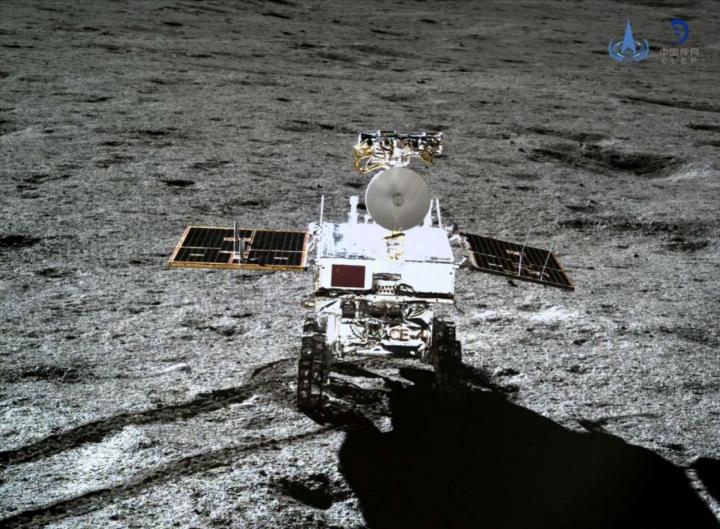
The lander and the rover of the Chang'e-4 probe switched to dormant mode for the lunar night on Friday, with the rover traveling an accumulated 178.9 meters on the far side of the moon.
The rover Yutu-2, or Jade Rabbit-2, is expected to awaken again on April 28, and the lander to awaken the following day, according to the Lunar Exploration and Space Program Center of the China National Space Administration.
The Chang'e-4 probe made the first-ever soft-landing on the Von Karman Crater in the South Pole-Aitken Basin on the far side of the moon on Jan. 3.
As a result of the tidal locking effect, the moon's revolution cycle is the same as its rotation cycle, and the same side always faces the Earth.
The far side of the moon was regarded as a virgin territory with unique features, and scientists expect important discoveries.
A lunar day equals 14 days on Earth, and a lunar night is the same length. According to the measurements of Chang'e-4, the temperature of the shallow layer of the lunar soil on the far side of the moon dropped to as low as minus 190 degrees Centigrade, lower than data obtained by the U.S. Apollo mission on the near side of the moon.
Quelle: Xinhua
----
Update: 29.04.2019
.
China's Chang'e-4 probe resumes work for fifth lunar day
The lander and the rover of the Chang'e-4 probe have resumed work for the fifth lunar day on the far side of the moon after "sleeping" during the extreme cold night.
The lander woke up at 7:40 a.m. Monday, and the rover, Yutu-2 (Jade Rabbit-2), awoke at 1:45 p.m. Sunday. Both are in normal working condition, according to the Lunar Exploration and Space Program Center of the China National Space Administration.
The rover has traveled an accumulated 178.9 meters on the moon and worked about one month longer than its designed life.
China's Chang'e-4 probe, launched on Dec. 8, 2018, made the first-ever soft landing on the Von Karman Crater in the South Pole-Aitken Basin on the far side of the moon on Jan. 3.
A lunar day equals 14 days on Earth, and a lunar night is the same length. The Chang'e-4 probe switched to a dormant mode during the lunar night due to the lack of solar power.
As a result of the tidal locking effect, the moon's revolution cycle is the same as its rotation cycle, and the same side always faces Earth.
The far side of the moon has unique features, and scientists expect Chang'e-4 could bring breakthrough findings.
The scientific tasks of the Chang'e-4 mission include low-frequency radio astronomical observation, surveying the terrain and landforms, detecting the mineral composition and shallow lunar surface structure and measuring neutron radiation and neutral atoms.
The Chang'e-4 mission embodies China's hope to combine human wisdom in space exploration with four payloads developed by the Netherlands, Germany, Sweden and Saudi Arabia.
Quelle: Xinhua
----
Update: 12.05.2019
.
China's lunar rover travels over 190 meters on moon's far side
China's lunar rover Yutu-2 has driven 190.66 meters on the far side of the moon to conduct scientific exploration on the virgin territory.
Both the lander and the rover of the Chang'e-4 probe switched to dormant mode for the lunar night on Saturday, according to the Lunar Exploration and Space Program Center of the China National Space Administration.
China's Chang'e-4 probe, launched on Dec. 8, 2018, made the first-ever soft landing on the Von Karman Crater in the South Pole-Aitken Basin on the far side of the moon on Jan. 3.
A lunar day equals 14 days on Earth, a lunar night the same length. The Chang'e-4 probe switches to dormant mode during lunar night due to lack of solar power.
During the fifth lunar day of the probe on the moon, the scientific instruments on the lander and rover worked well. A total of 6.6GB of scientific detection data has been sent to the core research team for analysis.
As a result of the tidal locking effect, the moon's revolution cycle is the same as its rotation cycle, and the same side always faces Earth.
The far side of the moon has unique features, and scientists expect Chang'e-4 could bring breakthrough findings.
The scientific tasks of the Chang'e-4 mission include low-frequency radio astronomical observation, surveying the terrain and landforms, detecting the mineral composition and shallow lunar surface structure and measuring neutron radiation and neutral atoms.
The Chang'e-4 mission embodies China's hope to combine wisdom in space exploration with four payloads developed by the Netherlands, Germany, Sweden and Saudi Arabia.
Quelle: Xinhua
----
Update: 16.05.2019
.
Chang'e 4 mission discovers new secrets from Lunar farside
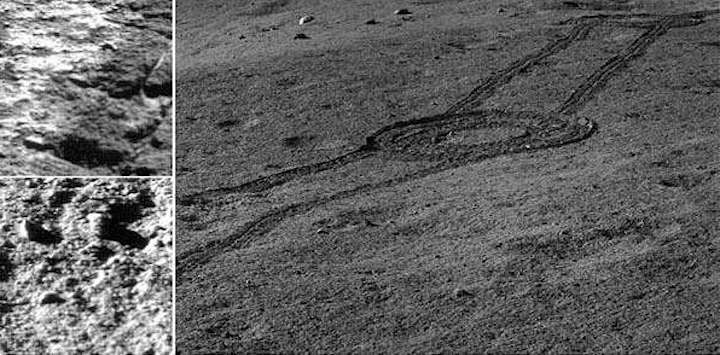
This is an image captured by Chang'E 4 showed the landscape near the landing site
A lunar lander named for the Chinese goddess of the moon may have lessened the mystery of the far side of the moon. The fourth probe of Chang'E (CE-4) was the first mission to land on the far side of the moon, and it has collected new evidence from the largest crater in the solar system, clarifying how the moon may have evolved.
A theory emerged in the 1970s that in the moon's infancy, an ocean made of magma covered its surface. As the molten ocean began to calm and cool, lighter minerals floated to the top, while heavier components sank. The top crusted over in a sheet of mare basalt, encasing a mantle of dense minerals, such as olivine and pyroxene.
As asteroids and space junk crashed into the surface of the moon, they cracked through the crust and kicked up pieces of the lunar mantel.
"Understanding the composition of the lunar mantel is critical for testing whether a magma ocean ever existed, as postulated," said corresponding author LI Chunlai, a professor of the National Astronomical Observatories of Chinese Academy of Sciences (NAOC). "It also helps advance our understanding of the thermal and magmatic evolution of the moon."
The evolution of the moon may provide a window into the evolution of Earth and other terrestrial planets, according to LI, because its surface is relatively untouched compared to, say, the early planetary surface of Earth.
LI and his team landed CE-4 in the moon's South Pole-Aitken (SPA) basin, which stretches about 2,500 kilometers-about half the width of China. CE-4 collected spectral data samples from the flat stretches of the basin, as well as from other, smaller but deeper impact craters within the basin.
The researchers expected to find a wealth of excavated mantle material on the flat floor of the SPA basin, since the originating impact would have penetrated well into and past the lunar crust. Instead, they found mere traces of olivine, the primary component of the Earth's upper mantle.
"The absence of abundant olivine in the SPA interior remains a conundrum," LI said. "Could the predictions of an olivine-rich lunar mantle be incorrect?"
Not quite. As it turns out, more olivine appeared in the samples from deeper impacts. One theory, according to LI, is that the mantle consists of equal parts olivine and pyroxene, rather than being dominated by one over the other.
CE-4 will need to explore more to better understand the geology of its landing site, as well as collect much more spectral data to validate its initial findings and to fully understand the composition of the lunar mantle.
The results were published on May 16, 2019, in Nature.
Quelle: SD
+++
Chang'e-4: Chinese rover 'confirms' Moon crater theory
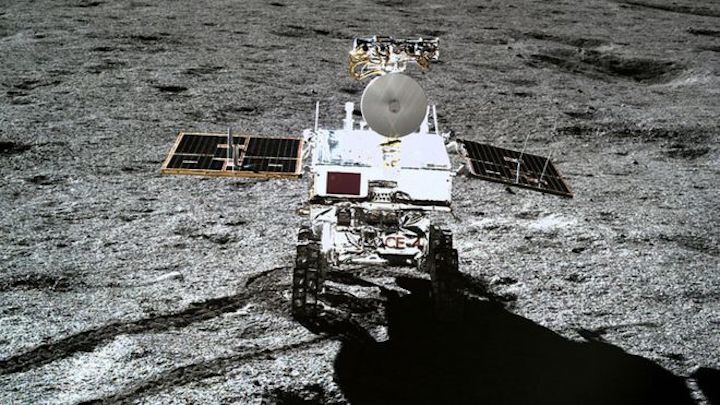
The Chinese Chang'e-4 rover may have confirmed a longstanding idea about the origin of a vast crater on the Moon's far side.
The rover's landing site lies within a vast impact depression created by an asteroid strike billions of years ago.
Now, mission scientists have found evidence that impact was so powerful it punched through the Moon's crust and into the layer below called the mantle.
Chang'e-4 has identified what appear to be mantle rocks on the surface.
It's something the rover was sent to the far side to find out.
Chunlai Li, from the Chinese Academy of Sciences in Beijing, and colleagues have presented their findings in the journal Nature.
The lunar far side, which is turned away from Earth, is more rugged than the familiar near side and has fewer "maria" - dark plains formed by ancient volcanic eruptions.
The Chinese spacecraft touched down on 3 January, becoming the first spacecraft to perform a soft landing on the lunar far side. The rover then rolled off the lander to explore its surroundings.
The rover landed inside a 180km-wide impact bowl called Von Kármán crater. But that smaller crater lies within the 2,300km-wide South Pole Aitken (SPA) Basin, which covers nearly a quarter of the Moon's circumference.
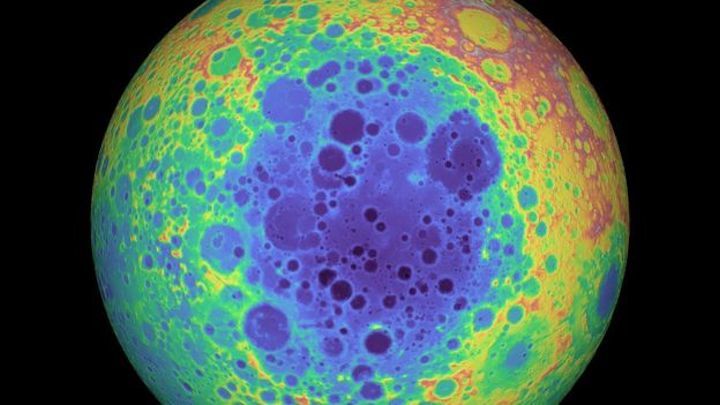
It's not known exactly how old the SPA Basin is, but it's thought to be at least 3.9 billion years old. The asteroid that carved it out is thought to have been about 170km wide.
The Yutu-2 rover has now identified rocks with a very different chemical make-up to those found elsewhere on the Moon.
Early results from the rover's Visible and Near Infrared Spectrometer (VNIS) suggest the rocks contain minerals known as low-calcium (ortho)pyroxene and olivine.
They fit the profile of rocks from the lunar mantle and suggest that the ancient impact that created the SPA drove right through the 50km-deep crust into the mantle.
Observational data taken by Moon-orbiting spacecraft have been inconclusive as to the presence of mantle rocks on the surface.
The authors of the paper want to continue their examination of these rocks and find others. They have also raised the possibility of sending another mission to deliver some of them to Earth for study in laboratories.
The results could now help scientists understand the chemical and mineralogical composition of the mantle, which could shed light on the origins and evolution of the Moon itself.
The team members also want to find out more about what happened after the asteroid collided with the Moon and formed the SPA Basin. Scientists predict that the hole in the surface may have been filled by molten rock - forming a "melt sheet" within the impact bowl, which complicates the picture of this region's geology.
Patrick Pinet, from the Research Institute in Astrophysics and Planetology (IRAP) in Toulouse, France, called the results "thrilling" and said they "could have considerable implications for characterising the composition of the Moon's upper mantle".
He added: "It is of the utmost importance to make progress towards unpacking the geology of the lunar far side, expanding our fundamental knowledge of the Moon's formation and the origin of the crustal asymmetry that exists between its near and far sides, and preparing future sample-return missions."
Quelle: BBC
+++
From the Lunar Far Side, China’s Rover Reveals Moon’s Hidden Depths
The Chang’e-4 mission appears to have found material excavated from a frozen magma ocean far below the lunar surface
In the 1960s and 1970s, the United States and the Soviet Union conducted unprecedented lunar exploration programs that remain unmatched to this day. The American crewed Apollo landings were complemented by uncrewed Soviet landings, with both yielding revolutionary bounties of scientific data, such as the hundreds of kilograms of lunar rock and soil that the missions returned to Earth. Oddly missing from all those samples, however, was any material that indisputably originated from the moon’s rocky mantle. Lying just beneath the cratered, desolate crust, the moon’s upper mantle is thought to be the frozen remnant of a vast magma ocean that existed more than 4 billion years ago. Directly studying samples of the mantle could unlock previously hidden chapters of lunar history, potentially reshaping our broader understanding of planetary formation and evolution. Now, a Chinese mission has discovered signs of mantle material at the moon’s surface, effectively setting an “X” on lunar maps for future explorers seeking this not-so-buried geological treasure.
China’s Chang’e-4 mission touched down near the south pole on the lunar far side on January 3, 2019, the first spacecraft ever to land intact on this largely unexplored region of the moon. Consisting of a lander and rover, the mission is still going strong today, with the rover—called Yutu-2—continuing its journey across the surface. On board are a variety of instruments, and today in Nature scientists from the Chinese Academy of Sciences in Beijing report the mission’s first scientific results, suggesting lunar mantle material has at last been located.
“We found that the material of the Chang’e-4 landing site is mainly composed of olivine and low-calcium pyroxene,” says Dawei Liu, one of the paper’s co-authors. “This mineral combination is the candidate mantle-derived material.”
Chang’e-4 rests inside the South Pole–Aitken (SPA) basin, which, at 2,500 kilometers across, is one of the solar system’s oldest and largest known impact craters. Specifically, the mission touched down in the 186-kilometer–wide Von Kármán crater within this larger basin. Von Kármán was produced billions of years ago by the impact of a large comet or asteroid; such collisions can excavate mantle material from deep underground, allowing it to be scattered across the surface by subsequent impacts. “These results seem to reveal that lunar mantle materials might be indeed exposed at the surface of the moon,” says Patrick Pinet from the French National Center for Scientific Research (CNRS) in Paris, who wrote an accompanying commentary on the findings.
The mantle material was discovered using the Visible and Near Infrared Spectrometer on Yutu-2, which can ascertain the chemical composition of rocks by studying their reflected light. Both olivine and pyroxene are believed to be among the first minerals that froze out from the moon’s magma ocean as it cooled, falling to its solid base deeper in the mantle. Because previous surveys from orbit have revealed much of Von Kármán’s floor to be composed of lava from volcanic eruptions rather than excavated mantle, the paper’s authors suspect the material detected by Yutu-2 was actually blasted into Von Kármán from the upper mantle beneath another nearby impact structure, the 72-kilometer–wide Finsen crater.
There are some caveats, however. Not everyone is convinced that Yutu-2 has definitively detected material from the lunar mantle. Mark Wieczorek from the Observatory of the Côte d'Azur in Nice, France, notes that the colossal SPA impact itself could have led to the formation of material that, while mantle-like, would be quite different from the moon’s actual mantle itself. And predictions had suggested a different composition would have resulted from the magma ocean’s crystallization—perhaps a sign of unexpected diversity in the lunar mantle’s makeup, if not a clue that Yutu-2 has not glimpsed any mantle material at all. “Though the Chang’e-4 data are exciting, the true origin of these rocks will probably only be determined by collecting new samples in this basin and returning them to Earth,” he says.
If confirmed, this first detection of mantle material on the lunar surface would provide a new window into the structure of the moon. Ananya Mallik from the University of Rhode Island notes that of the 1,737-kilometer lunar radius, about 300 kilometers form a dense metallic core at its center and 40 kilometers comprise the crust. “So, the remaining 1,397 kilometers is the mantle—which is huge!” she says, with seismic data from Apollo-era investigations providing the bulk of that prior knowledge. “Thus, understanding what the mantle is made of is a huge piece in the puzzle to unravel the lunar interior structure and composition.”
Results like these are a boon for China’s lunar exploration program too, helping justify its cost and bolstering arguments for future missions, even crewed forays to the surface, says Andrew Jones, a journalist covering the Chinese space program. “The apparent detection of lunar-mantle–derived material and the mission as a whole demonstrates that the country can plan and execute cutting-edge science missions and make new contributions in terms of human knowledge and understanding,” he says. “We are now starting to see the first science results.”
Yutu-2 is continuing to operate nominally on the surface, having driven nearly 200 meters, and it could survive for many months to come. In late 2019, China also hopes to launch another mission to the moon, called Chang’e-5, which will be the country’s first-ever sample return mission from the lunar surface. Alas, that mission is targeted for the moon’s near side, far from Von Kármán and Yutu-2’s remarkable potential discovery. For now, exploration of the Moon’s deep interior—and deeper past—will have to wait.
Quelle: SCIENTIFIC AMERICAN
+++
China Focus: Chinese lunar rover's "lucky" find could unlock secrets of moon & earth
China's Yutu-2, the first rover on the far side of the moon, has found materials from deep inside the moon that could help unravel the mystery of the lunar mantle composition and the formation and evolution of the moon and the earth.
Using data obtained by the visible and near infrared spectrometer installed on Yutu-2, a research team led by Li Chunlai, with the National Astronomical Observatories of China under the Chinese Academy of Sciences, found that the lunar soil in the landing area of the Chang'e-4 probe contains olivine and pyroxene which came from the lunar mantle deep inside the moon.
The first important scientific discovery of the Chang'e-4 probe since it made the first-ever soft landing on the far side of the moon was published online in the latest issue of the academic journal Nature.
The moon comprises a core, mantle and crust, like the earth. With the evolution of lunar magma, the light plagioclase rose to the upper layer to form the lunar crust, while the heavier olivine and pyroxene sank to form the lunar mantle, Li said.
"But since the lunar crust is very thick, and there has been no volcanic activity and plate movement on the moon for billions of years, it's hard to find materials from the lunar mantle on the surface," Li said.
The composition of the lunar mantle has long been the subject of theory. Neither the lunar samples from missions by the United States and Soviet Union, nor the remote sensing probes orbiting the moon have provided direct evidence of the accurate composition of the lunar mantle.
Chinese scientists focused on a special area on the far side of the moon -- the South Pole-Aitken (SPA) Basin, which was formed by a celestial collision over 4 billion years ago. With a diameter of 2,500 km and a depth of about 13 km, the basin is the oldest and largest impact crater on the moon.
After Chang'e-4 successfully landed on the Von Karman Crater in SPA Basin on Jan. 3 this year, the Yutu-2 rover obtained good quality spectral data at two sites.
"The data, unlike that obtained by Yutu on the near side of the moon, gave us a pleasant surprise," said Li.
Analysis showed the lunar soil in the landing area contains a large amount of olivine, low-calcium pyroxene and a small amount of high-calcium pyroxene, which are very likely from the lunar mantle, Li said.
So how did the materials from deep inside the moon get there?
After analyzing the high-resolution remote sensing images and the hyperspectral data, the researchers believed the materials were ejected from a 72-km-wide crater named Finsen to the northeast of the Von Karman Crater.
Li explained that after the SPA Basin was formed, more small asteroids crashed into the area, leading to more small craters. The collision that caused the Finsen Crater might have been so violent that the materials were knocked into the Von Karman Crater.
When scientists were selecting the landing site for Chang'e-4, flat areas were given priority. However, most of the flat areas on the moon are basalt formed as magma solidified.
It was lucky that Chang'e-4 probe landed in a region where the basalt is covered by lunar mantle debris.
"Furthermore, the rover is driving at the edge of the ejecta. According to our calculation, it might reach the basalt area in another 2 km or so. When it reaches the basalt area, we can compare the composition of the different lunar soils," Li said.
He said the study could provide a reference for a future mission to collect and return with samples and even the construction of a lunar base.
If the planned Chang'e-6 probe can go to that area, it would not only get the first-ever sample from the far side of the moon, but also have the chance to collect samples of materials coming from deep inside the moon, Li said.
"Most of the evolution of the moon happened about 3 billion years ago, while the early history of Earth before 3 billion years ago has been erased by geological activities. The moon is like a fossil that gives a glimpse of the early history of Earth," Li added.
Quelle: Xinhua
+++

A lunar lander named for the Chinese goddess of the moon may have lessened the mystery of the far side of the moon. The fourth probe of Chang'E (CE-4) was the first mission to land on the far side of the moon, and it has collected new evidence from the largest crater in the solar system, clarifying how the moon may have evolved.
The results were published on May 16, 2019, in Nature.
A theory emerged in the 1970s that in the moon's infancy, an ocean made of magma covered its surface. As the molten ocean began to calm and cool, lighter minerals floated to the top, while heavier components sank. The top crusted over in a sheet of mare basalt, encasing a mantle of dense minerals, such as olivine and pyroxene.
As asteroids and space junk crashed into the surface of the moon, they cracked through the crust and kicked up pieces of the lunar mantel.
"Understanding the composition of the lunar mantel is critical for testing whether a magma ocean ever existed, as postulated," said corresponding author LI Chunlai, a professor of the National Astronomical Observatories of Chinese Academy of Sciences (NAOC). "It also helps advance our understanding of the thermal and magmatic evolution of the moon."
The evolution of the moon may provide a window into the evolution of Earth and other terrestrial planets, according to LI, because its surface is relatively untouched compared to, say, the early planetary surface of Earth.
LI and his team landed CE-4 in the moon’s South Pole-Aitken (SPA) basin, which stretches about 2,500 kilometres-about half the width of China. CE-4 collected spectral data samples from the flat stretches of the basin, as well as from other, smaller but deeper impact craters within the basin.
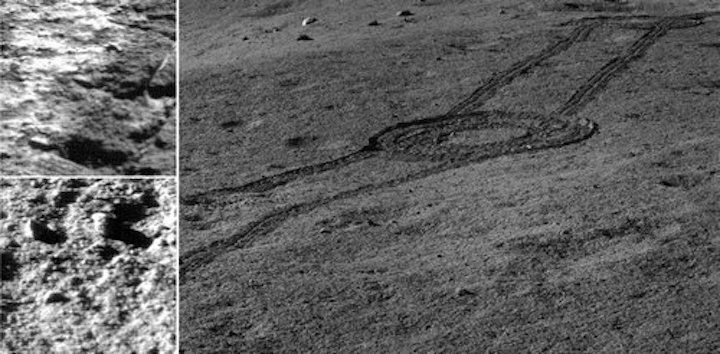
Fig.1: Image captured by Chang’E 4 showed the landscape near the landing site. (Image by NAOC/CNSA)
The researchers expected to find a wealth of excavated mantle material on the flat floor of the SPA basin, since the originating impact would have penetrated well into and past the lunar crust. Instead, they found mere traces of olivine, the primary component of the Earth’s upper mantle.
"The absence of abundant olivine in the SPA interior remains a conundrum," LI said. "Could the predictions of an olivine-rich lunar mantle be incorrect?"
Not quite. As it turns out, more olivine appeared in the samples from deeper impacts. One theory, according to LI, is that the mantle consists of equal parts olivine and pyroxene, rather than being dominated by one over the other.

Fig.2: Image captured by Chang'E 4 showed the landscape near the landing site. (Image by NAOC/CNSA)
CE-4 will need to explore more to better understand the geology of its landing site, as well as collect much more spectral data to validate its initial findings and to fully understand the composition of the lunar mantle.
This work was supported by the Chang’E-4 mission of the Chinese Lunar Exploration Program.
Other contributors from the Key Laboratory of Lunar and Deep Space Exploration in the National Astronomical Observatories of the Chinese Academy of Sciences include LIU Dawei, LIU Bin, REN Xin, LIU Jianjun, ZUO Wei, ZENG Xingguo, TAN Xu, ZHANG Xiaoxia, CHEN Wangli, WEN Weibin, SU Yan, ZHANG Hongbo, and OUYANG Ziyuan, who is also affiliated with the Institute of Geochemistry. HE Zhiping, XU Rui, and SHU Rong of the Shanghai Institute of Technical Physics also contributed.
About the National Astronomical Observatories of Chinese Academy of Sciences (NAOC):
The National Astronomical Observatories of Chinese Academy of Sciences (NAOC) was officially founded in April 2001 through the merger of observatories, stations and research center under Chinese Academy of Sciences. It is headquartered in Beijing and has four subordinate units across the country: the Yunnan Observatory (YNAO), the Nanjing Institute of Astronomical Optics and Technology (NIAOT), the Xinjiang Astronomical Observatory (XAO) and the Changchun Observatory. NAOC conducts cutting-edge astronomical studies, and operates major national facilities including The Large Sky Area Multi-Object Fiber Spectroscopy Telescope (LAMOST), the Five-hundred-meter Aperture Spherical Telescope (FAST) etc.
NAOC’s main research involves cosmological large-scale structures, the formation and evolution of galaxies and stars, high-energy astrophysics, solar magnetism and activity, lunar and deep space exploration, and astronomical instrumentation. NAOC has seven major research divisions in the areas of optical astronomy, radio astronomy, galaxies and cosmology, space science, solar physics, lunar and deep space exploration, and applications in astronomy.
Quelle: Chinese Academy of Sciences
----
Update: 30.05.2019
.
China's Chang'e-4 probe resumes work for sixth lunar day
The lander and the rover of the Chang'e-4 probe have resumed work for the sixth lunar day on the far side of the moon after "sleeping" during the extremely cold night.
The lander woke up at 6 p.m. Tuesday, and the rover, Yutu-2 (Jade Rabbit-2), awoke at 2:16 a.m. Tuesday, according to the Lunar Exploration and Space Program Center of the China National Space Administration.
For the sixth lunar day, the lander's neutron radiation detector and low-frequency radio detector will be restarted to conduct scientific tasks including particle radiation observation and low-frequency radio astronomical observation.
The rover's panoramic camera, detection radar, infrared imaging spectrometer and neutral atom detector will be restarted during the sixth lunar day.
China's Chang'e-4 probe, launched on Dec 8, 2018, made the first-ever soft landing on the Von Karman Crater in the South Pole-Aitken Basin on the far side of the moon on Jan. 3.
A lunar day equals 14 days on Earth, and a lunar night is the same length. The Chang'e-4 probe switched to a dormant mode during the lunar night due to the lack of solar power.
As a result of the tidal locking effect, the moon's revolution cycle is the same as its rotation cycle, and the same side always faces Earth.
The far side of the moon has unique features, and scientists expect Chang'e-4 to provide breakthrough findings.
The scientific tasks of the Chang'e-4 mission include low-frequency radio astronomical observation, surveying the terrain and landforms, detecting the mineral composition and shallow lunar surface structure and measuring neutron radiation and neutral atoms.
The Chang'e-4 mission embodies China's hope to combine human wisdom in space exploration with four payloads developed by the Netherlands, Germany, Sweden and Saudi Arabia.
Quelle: Xinhua
----
Update: 27.06.2019
.
China's Chang'e-4 probe resumes work for 7th lunar day
The lander and the rover of the Chang'e-4 probe have resumed work for the seventh lunar day on the far side of the moon after "sleeping" during the extreme cold night.
The lander woke up at 9:45 a.m. Thursday, and the rover, Yutu-2 (Jade Rabbit-2), awoke at 1:26 p.m. Wednesday. Both are in normal working condition, according to the Lunar Exploration and Space Program Center of the China National Space Administration.
The rover has traveled more than 212 meters on the moon to conduct scientific exploration on the virgin territory.
China's Chang'e-4 probe, launched on Dec. 8, 2018, made the first-ever soft landing on the Von Karman Crater in the South Pole-Aitken Basin on the far side of the moon on Jan. 3.
A lunar day equals 14 days on Earth, and a lunar night is the same length. The Chang'e-4 probe switched to a dormant mode during the lunar night due to the lack of solar power.
As a result of the tidal locking effect, the moon's revolution cycle is the same as its rotation cycle, and the same side always faces Earth.
The scientific tasks of the Chang'e-4 mission include low-frequency radio astronomical observation, surveying the terrain and landforms, detecting the mineral composition and shallow lunar surface structure and measuring neutron radiation and neutral atoms.
The Chang'e-4 mission embodies China's hope to combine human wisdom in space exploration with four payloads developed by the Netherlands, Germany, Sweden and Saudi Arabia.
Quelle: Xinhua
----
Update: 29.06.2019
.
Chang’e-4 begins lunar day 7 after Yutu-2 rover overcomes cosmic challenges
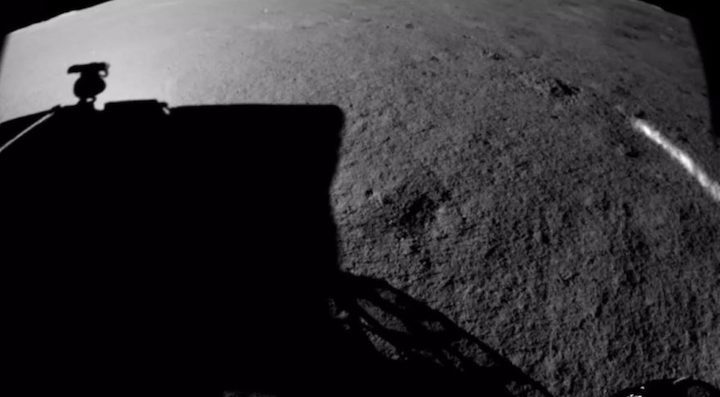
HELSINKI — The Chang’e-4 lander and Yutu-2 rover resumed science and exploration activities June 27 for the start of the mission’s seventh lunar day on the far side of the moon.
The 140-kilogram Yutu-2 (Jade Rabbit-2) rover awoke at 1:26 a.m. Eastern, followed by the lander at 9:45 p.m., with both spacecraft and their science payloads working normally, according to an update from the Lunar Exploration and Space Program Center of the China National Space Administration issued Thursday.
The spacecraft had powered down on the morning of June 9, folding solar arrays in preparation for the 14.5-Earth-day-long lunar night, during which the pair use radioisotope heater units to protect against temperatures as low as minus 190 Celsius (minus 310 Fahrenheit).
According to a ‘Yutu-2 driving diary’ published June 27 (Chinese), the rover had suffered issues during lunar day six which caused interference with communications between the Yutu-2 rover and the Queqiao (“Magpie Bridge”) relay satellite, stationed around the second Earth-moon Lagrange point to facilitate communications between ground stations and the spacecraft on the far side of the moon, which never faces the Earth.
The issue meant a loss of telemetry and contact with Yutu-2. Analysis indicated an error caused by a cosmic ray striking a rover microchip and the issue was resolved successfully, according to the article, adding that the incident was a reminder that the space environment is complex and variable.
Mission scientists with the Key Laboratory of Lunar and Deep Space Exploration under the Chinese Academy of Sciences had not responded to a request for comment at press time.
Cosmic rays, high-energy atomic fragments originating beyond the solar system, have caused issues for numerous spacecraft, including NASA’s Mars rovers and the Dawn spacecraft which visited asteroids Ceres and Vesta.
Yutu-2 progress in Von Kármán crater
The Yutu-2 rover had driven a total of 212.99 meters in Von Kármán crater within the South Pole-Aitken Basin by the end of lunar day six, heading west from the ‘Statio Tianhe’ landing site.
Philip Stooke of the Centre for Planetary Science and Exploration at the University of Western Ontario, Canada, has plotted a map of the rover’s driving, using accurate data released by China for days 1-3, and a tentative route for days 4-6 derived from images and tracks released in official updates.
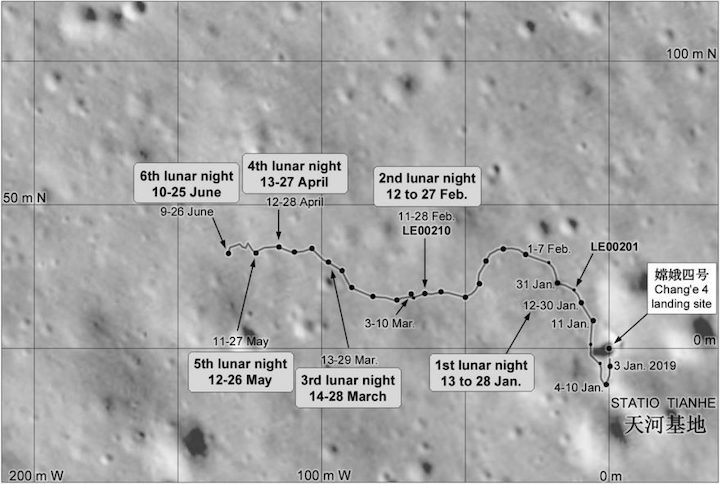
Images released by the NASA Lunar Reconnaissance Orbiter Camera (LROC) team June 28 show the progress of Yutu-2 across lunar days up to June 3. Tracks from the rover are visible in some images, matching closely to the map above. Based on the visible tracks, the LROC team put the rover’s traverse progress at 186 meters up to the middle of lunar day 6, somewhat shorter than the figure released by China.
Chang’e-4 made the first-ever soft-landing on the far side of the moon on Jan. 2, 2019, and has since been carrying out science objectives with a Low-Frequency Spectrometer and Lunar Lander Neutrons and Dosimetry experiment aboard the lander, and a Lunar Penetrating radar, Visible and Near-Infrared Imaging Spectrometer, Advanced Small Analyzer for Neutrals, and Panoramic Camera on the Yutu-2 rover.
In May a paper published in Nature laid out potential evidence of the detection of material originating within the lunar mantle, based on early visible and near infrared spectrometry measurements taken by the rover.
The Chang’e-4 spacecraft have been operating on the lunar far side for 175 days. Yutu-2 has passed its design lifetime of three months, but Liu Dianfu of the Beijing Institute of Spacecraft Environment Engineering expressed hopes late March that the rover can operate for at least one year.
The lander has a design lifetime of one year. However the Chang’e-3 lander, on which Chang’e-4 is based, is understood to still be functioning with one payload after landing in Mare Imbrium in December 2013.
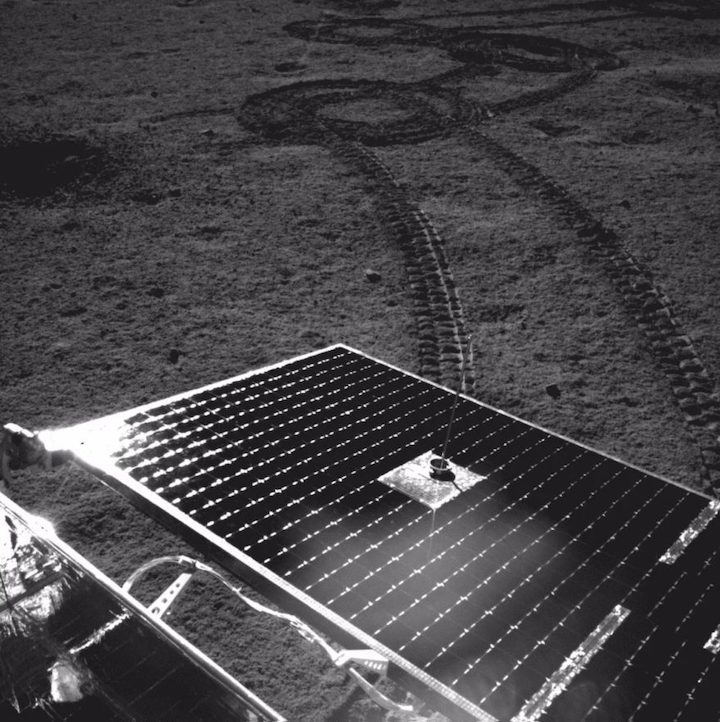
Yutu-2 imaging one of its solar panels and tracks made during lunar day six. Credit: China Lunar Exploration Program/China National Space Administration
Quelle: SN
